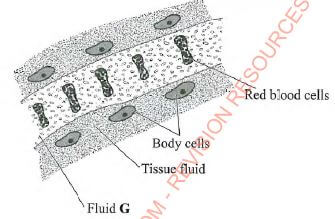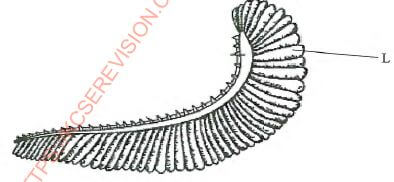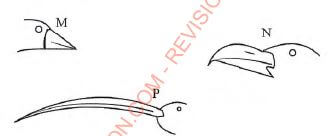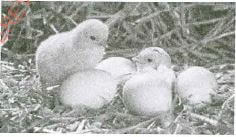QUESTIONS
-
- Name the cell organelle found in abundance in the white blood cells.(1 mark)
- Give a reason for your answer in (a) above.(1 mark)
- State two observable features that place a millipede into its Class.(2 marks)
- Which sets of teeth would be used in chewing sugarcane for maximum extraction of sap?(2 marks)
- A group of form two students placed a fresh leaf in warm water. They observed that air bubbles formed on the surface of the leaf.
- What biological process were they investigating?(1 mark)
- Name the structures from which the air bubbles were coming from.(1 mark)
- Explain the distribution of the structures named in (b) above on the leaf surfaces of a land plant.(2 marks)
- State why it is important for plants to lose water to the atmosphere.(3 marks)
- The diagram below illustrates tissue fluid and cells surrounding a capillary.

- Name fluid G.(1 mark)
- Give two ways by which fluid G is different from tissue fluid.(2 marks)
-
- Define respiration(1 mark)
- State three activities in the human digestive system that depend on respiration.(3 marks)
- State three ways in which blood capillaries are structurally adapted to their functions(3 marks)
- The diagram below represents an organ in a bony fish.

- Name the organ.(1 mark)
- Describe how air in water reach the capillaries inside structure L.(3 marks)
- Name two products of respiration in plants.(2 marks)
-
- State one homeostatic role of the human skin.(1 mark)
- Name three structures of the skin essential for its homeostatic function.(3 marks)
- Explain why the nephron is long and convoluted.(3 marks)
- State two limitations of us.ng a quadrat to estimate the population of organisms.(2 marks)
- The diagram below illustrates a germinating seedling.

- Name the type of germination illustrated in the diagram.(1 mark)
- Describe how the type of germination named in (a) abave is brought about.(3 marks)
- Explain why a bony fish dies shortly after being removed from water.(4 marks)
- Name the bones that articulate to form a ball and socket joint at the hip.(2 marks)
- Explain the role of carbonic anhydrase in red blood cells.(3 marks)
- A tall, light skinned lady with pimples on her face has lorg hair and limps.
- List two features which the lady has that are due to inheritance.(2 marks)
- Explain why most recessive genes arc cxpressed prenotypically in male offspring of humans.(3 marks)
- The diagrams below illustrate some forms of beaks in birds.

- Which diagram represents the beak from which the others are likely to have evolved?(1 mark)
- Explain your answer in (a) above.(3 marks)
-
- Define the term analogous structures.(1 mark)
- Give two illustrations of analogous structures in mammals.(2 marks)
- State two ways in which plants with weak stems obtain mechanical support(2 marks)
- What does the term evolution mean?(1 mark)
- State two characteristics of living things illustrated in the photograph below.(2 marks)

- Explain why a camel has a longer nephron than a whale.(3 marks)
MARKING SCHEME
-
- Lysosomes/golgi apparatus;
- White blood cells fight pathogens to protect the body, the lysosomes contain lytic enzymes which destroy pathogens;/golgi apparatus synthesize lysosomes which contain lytic enzymes that destroy parthogens;
-
- Cylindrical body;
- 9--100 segments;
- Each segment has two pairs of legs;
- Pair of short antennae;
- Has two clumps of many simple eyes;
- Has anterior genital pore/apparatus;
- Has three body parts (head, thorax and trunk);
Any 2
- Premolars; molars;
-
- Photosynthesis;/gaseous exchange in plants,
- Stoma/somata;
- Are more on the lower surface of terrestrial plants/fewer on the upper surface; to reduce transpiration;
-
- Cools the plant;
- For uptake of water up the xylem vessels;
- Mechanism through which mineral elements are transported in the plant;
- Removal excess water;
- Maintains turgor pressure;
-
- (Blood) plasma;(1 mark)
- Has (more large) proteins/blood platelets;
High (hydrostatic) pressure/low pressure of tissue fluid;
Has red blood cells;
-
- Process by which living organisms/cells break down loxidize (organic) food materials into simpler compounds to release energy:
- -Peristalsis;
-Absorption of materials;
-Chewing (movement of jaw muscles);
-Churning; -Secretion of digestive enzymes
Any 3 (3 marks)
-
- Numerous to increase surface area through which materials diffuse;
- Thin/one-cell thick/single cell epithelium'endothelium for faster diffusion;
- • Lined with a single cell epithelium for faster diffusion;
- Are selectively permeable for passage of materials,
- Narrow lumen to maintain preesure;
Any 3
-
- Gill;
- Fish mouth opens lowering pressure in buccal cavity and water rushes in; mouth closes increasing pressure that forces water into the gill cavity/opercular cavity; O2 rich water flows over the gills in a counter current direction to capillary blood flow, causing O2 to diffuse into the gill capillaries;
Any 3
-
- Water;
- Carbon (IV)oxide;
- Energy/Adenosine Triphosphate;
- Alcohol/ethanol/ethyl alcohol;
Any 2
-
- Thermoregulation;
Osmoregulation;
Regulating salt balance;
Any 1 - - Blood vessels/arterioles;
- Hair,
- Sweat glands;
- Erector pili muscles;
- Nerve endings
Any 3
- Thermoregulation;
-
- To fit in the limited space) in the kidney/occupy less space;
- Increase surface area for selective) reabsorption;
- Allow for more time for (selective) reabsorption;
-
- Cannot be used for most animals/plants;
- Assumes organisms are evenly distributed;
- Inaccuracy (over/under-estimation);
Any 2
-
- Epigeal;
- Hypocotyl elongates faster than the epicotyl;
pushing cotyledons above the ground;
- Fish uses dissolved oxygen for gaseous exchange: gill filament epithelium dries up; gill filaments clamp together; surface area for gaseous exchange reduced; oxygen lacks moist surface for dissolution causing death(due to suffocation);
- Femur;
Pelvic girdle; - Converts carbon (IV) oxide to carbonic acid; which easily dissociates into hydrogen ions (H+ and hydrogen carbonates (HCO3-for easier transportation; reducing acidity in blood;
-
- Height (tallness);
Long hair;
Skin colour (light);
Any 2 - Most of the genes are sex-linked and are carried on the X chromosomes: boys receive X chromosomes from the mother (and Y chromosomes from the father); if the X carries a recessive gene, it is more likely to be phenotypically expressed in boys;
- Height (tallness);
-
- Beak M
- Beak M is simple/basic; original beak; the birds separated to occupy different niches, and specialized for different diets; leading to more complex/developed beaks over time; Any 3
-
- Different embryonic origin but evolved to perform similar functions due to exploitation of same kind of environment);
- -Wings of bats and insects;
-Eyes of mammals and molluscs;
-Limbs of mammals and arthropods;
-Flipper in whales/dolphins and fins of fish;
-
- Twinning around a support:
- Use of tendrils/spines/thorns/hooks (to cling on nearby plants/trees);
- Turgid cells in their stems);
Any 2
- Gradual change from simple life forms to complex forms over a (long) period of time;
-
- Growth; and development;
- Reproduction: C
-
- A camel is a desert animal, a longer nephron increases the surface area for reabsorption of water, to conserve it; a whale is aquatic animal, (does not need to conserve water);
-
- Aestivation;
- Reduced metabolic activity; hence low rate of respiration; minimizing water loss/ dessication (to the environment);
-
- Less-toxic;
- Very soluble;
- A small molecule (easily filtered in the kidneys);
- Requires less water to excrete; Any 2
- Mouse is active/has a large surface area to volume ratio; hence has a higher metabolic rate (rate of breathing) to cope with the rate at which energy (oxygen) is consumed or lost to the environment; an elephant is less active/has a small surface area to volume ratio hence has a lower rate at which energy (oxygen) is used or lost; or Mouse is small in size/has large surface area to volume ratio, hence has a metabolic rate (rate of breathing) to cope with the rate at which oxygen is consumed/energy is lost to the environment, an elephant is large in size/has small surface area to volume ratio; hence has a lower rate at which oxygen/energy is lost;
Join our whatsapp group for latest updates
Tap Here to Download for 50/-
Get on WhatsApp for 50/-
Download KCSE 2018 Biology Paper 1 with Marking Scheme.
Tap Here to Download for 50/-
Get on WhatsApp for 50/-
Why download?
- ✔ To read offline at any time.
- ✔ To Print at your convenience
- ✔ Share Easily with Friends / Students

